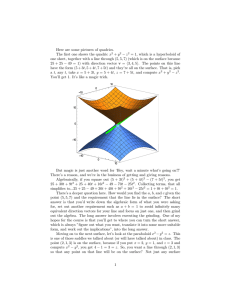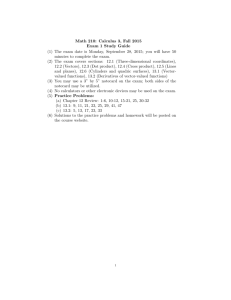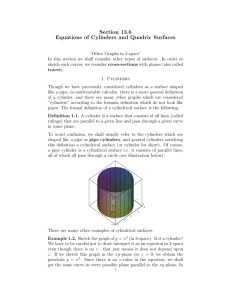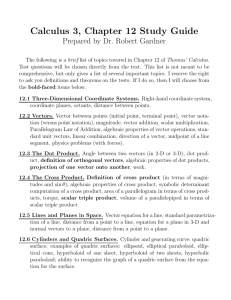Quadric Representation and Clifford Minimal Hypersurfaces Th. Hasanis Th. Vlachos
advertisement
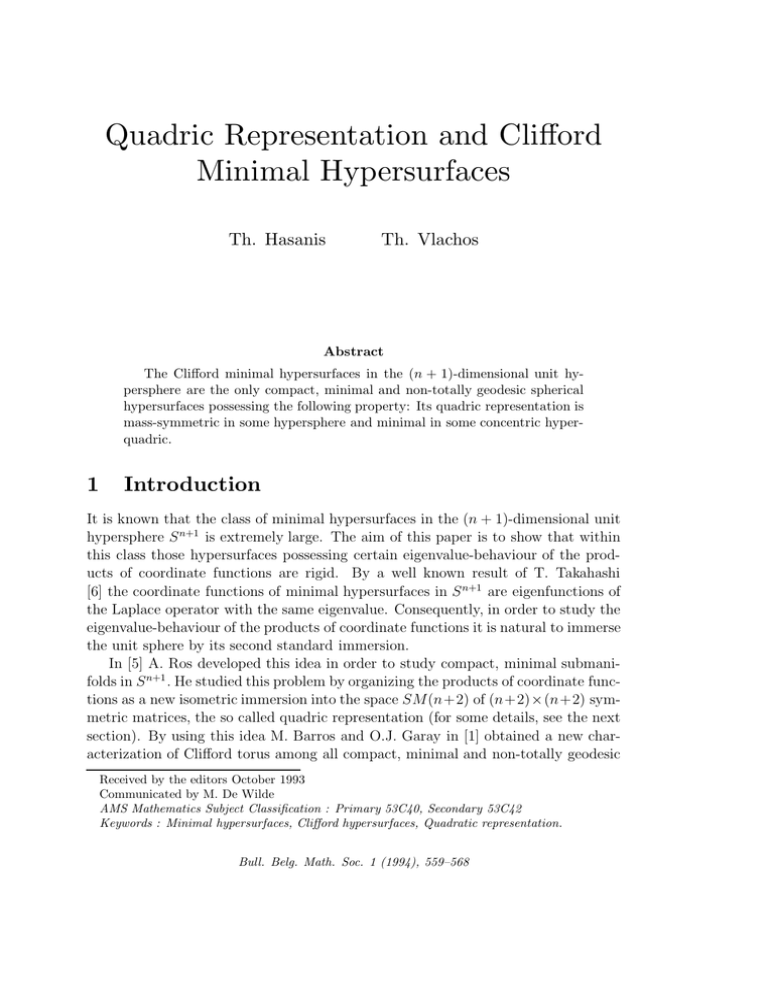
Quadric Representation and Clifford
Minimal Hypersurfaces
Th. Hasanis
Th. Vlachos
Abstract
The Clifford minimal hypersurfaces in the (n + 1)-dimensional unit hypersphere are the only compact, minimal and non-totally geodesic spherical
hypersurfaces possessing the following property: Its quadric representation is
mass-symmetric in some hypersphere and minimal in some concentric hyperquadric.
1
Introduction
It is known that the class of minimal hypersurfaces in the (n + 1)-dimensional unit
hypersphere S n+1 is extremely large. The aim of this paper is to show that within
this class those hypersurfaces possessing certain eigenvalue-behaviour of the products of coordinate functions are rigid. By a well known result of T. Takahashi
[6] the coordinate functions of minimal hypersurfaces in S n+1 are eigenfunctions of
the Laplace operator with the same eigenvalue. Consequently, in order to study the
eigenvalue-behaviour of the products of coordinate functions it is natural to immerse
the unit sphere by its second standard immersion.
In [5] A. Ros developed this idea in order to study compact, minimal submanifolds in S n+1 . He studied this problem by organizing the products of coordinate functions as a new isometric immersion into the space SM(n+2) of (n+2)×(n+2) symmetric matrices, the so called quadric representation (for some details, see the next
section). By using this idea M. Barros and O.J. Garay in [1] obtained a new characterization of Clifford torus among all compact, minimal and non-totally geodesic
Received by the editors October 1993
Communicated by M. De Wilde
AMS Mathematics Subject Classification : Primary 53C40, Secondary 53C42
Keywords : Minimal hypersurfaces, Clifford hypersurfaces, Quadratic representation.
Bull. Belg. Math. Soc. 1 (1994), 559–568
560
Th. Hasanis – Th. Vlachos
surfaces in S 3. They proved that: The Clifford torus is the only compact minimal and
non-totally geodesic surface in S 3, whose quadric representation is mass-symmetric
in some hypersphere and minimal in some concentric hyperquadric. The proof of
their result is based on the study of the nodal sets associated with the coordinate
functions due to S.Y. Cheng [2].
In this paper we obtain a characterization of Clifford minimal hypersurfaces in
n+1
S . More precisely we prove the next result.
Theorem. Let x : M n → S n+1 be a compact, minimal hypersurface in the unit
hypersphere S n+1 . Let ϕ : M n → SM(n + 2) be its quadric representation with
center of mass ϕ0 ∈ SM(n + 2). Then ϕ is mass-symmetric in some hypersphere
and minimal in some hyperquadric of SM(n + 2) centered at ϕ0 , if and only if,
either M n is totally geodesic in S n+1 or M n is a Clifford minimal hypersurface
S p(
q
p
)×S n−p (
n
q
n−p
)
n
with 1 ≤ p < n and ϕ0 is a matrix similar to a diagonal matrix
with (p + 1) eigenvalues equal to
equal to
2
p
n(p+1)
and the remaining (n − p + 1) eigenvalues
n−p
.
n(n−p+1)
Preliminaries
Let SM(n+2) = {P ∈ gl(n+2, R)/P = P t } be the space of the symmetric matrices
of order n + 2, where P t denotes the transpose. We define on SM(n + 2) the metric
g(P, Q) = 12 tr P Q for all P, Q in SM(n + 2). Let x : S n+1 → E n+2 be the unit
hypersphere centered at the origin embedded in the standard way. Regarding the
vectors of E n+2 as column matrices in E n+2 , the map f : S n+1 → SM(n + 2) given
by f(x) = xxt defines an isometric immersion of S n+1 into SM(n + 2) which is
actually the second standard immersion of S n+1 .
The normal space of the immersion f at any point x of S n+1 is given by
Tx⊥ S n+1 = {P ∈ SM(n + 2)/P x = λx, for some real λ}.
In particular, we have f(x) ∈ Tx⊥S n+1 . If σ̄ denotes the second fundamental form of
the immersion f, we have
(1)
σ̄(X, Y ) = XY t + Y X t − 2hX, Y if(x)
for all X, Y in TxS n+1 , where h, i is the standard inner product in E n+2 . It is well
known [5] that σ̄ is parallel and satisfies the following properties:
g(σ̄(X, Y ), σ̄(V, W )) = 2hX, Y ihV, W i + hX, V ihY, W i + hX, W ihY, V i,
Āσ̄(X,Y ) V = 2hX, Y iV + hX, V iY + hY, V iX,
g(σ̄(X, Y ), f(x)) = −hX, Y i,
g(σ̄(X, Y ), I) = 0,
where I is the identity matrix in SM(n + 2), Ā is the Weingarten map of f and
X, Y, V, W are tangent vectors to S n+1 . Moreover S n+1 is immersed by the second
Quadric Representation and Clifford Minimal Hypersurfaces
561
standard immersion f as a minimalqsubmanifold of a hypersphere of SM(n + 2)
n+1
centered at I/n + 2 and with radius 2(n+2)
(see [5]).
Let, now, x : M n → S n+1 be an isometric immersion of a compact Riemannian
manifold M n into S n+1 . The isometric immersion ϕ = f ◦ x : M n → SM(n + 2)
is called the quadric representation of x since coordinates of ϕ depend on x in
a quadric manner. The center of mass of ϕ is the symmetric matrix (αij ) with
R
1
n
αij = vol(M
n ) M n xi xj dM , where xi (i = 1, . . . , n + 2) are the coordinate functions
of x with respect to a constant coordinate system in E n+2 and dM n denotes the
volume element of M n . We note that the quadric representation of an isometric
immersion x : M n → S n+1 , and its center of mass depend on the chosen coordinate
system of E n+2 .
Using (1) we find that the mean curvature vector field H of the quadric representation is given by
H = H1 xt + xH1t +
(2)
n
2X
Ei Eit − 2xxt ,
n i=1
where {E1, . . . , En } denotes an orthonormal frame of M n and H1 the mean curvature
vector field of the immersion x : M n → S n+1 .
Example. Let S q (r) denote a q-dimensional sphere in E q+1 with radius r. Let
n, p be positive integers such that p < n and the Riemannian product Mp,n−p =
S p(
q
p
) × S n−p (
n
q
n−p
).
n
We imbed Mp,n−p into S n+1 as follows. Let (u, v) be a point
of Mp,n−p where u (resp. v) is a vector in E p+1 (resp. E n−p+1 ) of length
q
n−p
).
n
q
p
n
(resp.
We can consider (u, v) as a unit vector in E n+2 = E p+1 × E n−p+1 . Then
Mp,n−p is a minimal hypersurface in the unit hypersphere S n+1 , the so called Clifford
minimal hypersurface. More precisely we have
r
x=
p~
θ1 +
n
s
n − p~
θ2 ,
n
where ~θ1 is the position vector field of the unit hypersphere in E p+1 and ~θ2 is the
position vector field of the unit hypersphere in E n−p+1 . It is obvious that the Laplace
n
∆2 , where ∆i is the Laplace operator
operator ∆ of Mp,n−p is given by ∆ = np ∆1 + n−p
of ~θi . Consider now the quadric representation ϕ : Mp,n−p → SM(n + 2). An easy
calculation, by using the averaging principle, shows the following spectral behaviour
(3)
∆(ϕij − αij ) = λij (ϕij − αij ),
where the center of mass ϕ0 = (αij ) of ϕ is given by
αij =
p
,
n(p + 1)
i=j ≤p+1
i=j ≥p+2
0,
n−p
,
n(n − p + 1)
i 6= j
562
Th. Hasanis – Th. Vlachos
and the eigenvalues are given by
2n(p + 1)
,
p
λij =
2n,
2n(n + 1 − p)
,
n−p
i, j ≤ p + 1
i ≥ p + 2 and j ≤ p + 1 or i ≤ p + 1 and j ≥ p + 2
i, j ≥ p + 2.
Moreover Mp,n−p is immersed via ϕ into some hypersphere of SM(n + 2) centered
at (αij ). Furthermore, using (3) we deduce that ϕ is minimal in the hyperquadric of
SM(n + 2) given by
n+2
X
λij (ϕij − αij )2 = n.
i,j=1
The next lemma was proved in [1].
Lemma 2.1. Let x : M n → E m be an isometric immersion of a compact Riemannian manifold M n in the Euclidean space E m . Let b = (b1 , b2, . . . , bm) denote the
center of mass of M n . Then
∆(xi − bi ) = λi (xi − bi ),
i = 1, . . . , m
if and only if:
(i) x is mass-symmetric in some hypersphere Sbm−1 centered at b and
(ii) x is minimal in the hyperquadric, concentric with Sbm−1 given by
m
X
αi (xi − bi)2 = k.
i=1
Moreover, in this case λi =
nαi
,
k
1 ≤ i ≤ m.
Remark 2.2. Comparing this Lemma with Theorem 2.2 of [4], we see that the results
are basically the same. However, this result is an extension of a result due to T.
Takahashi [6].
3
Proof of Theorem
At first, it is convenient to prove some lemmas.
Lemma 3.1. Let x : M n → S n+1 be an isometric immersion of the compact manifold M n in S n+1 . Assume that A = (αij ) is the center of mass of its quadric representation ϕ : M n → SM(n + 2). Let P be an (n + 2) × (n + 2) orthogonal matrix
and ψ : M n → SM(n + 2) the quadric representation of the isometric immersion
y = P x : M n → S n+1 . If B = (bij ) is the center of mass of the quadric representation
ψ, then B = P AP t.
Proof. By integration, since yy t = P xxtP t , we obtain the desired result. Thus the
centers of mass A, B are similar matrices. 2
Quadric Representation and Clifford Minimal Hypersurfaces
563
Remark 3.2. The center of mass A of the quadric representation ϕ of an isometric
immersion x : M n → S n+1 is a positive-definite matrix unless x(M n ) is totally
geodesic in S n+1 . In fact, since A is a symmetric matrix there exists an orthogonal
matrix P such that P AP t = diag[λ1, . . . , λn+2 ], where λi are the eigenvalues of A.
The matrix diag[λ1 , . . . , λn+2 ] is the center of mass of the quadric representation of
R
the isometric immersion y = P x. Since, λi V ol(M n ) = M n yi2 dM n we conclude, by
using Lemma 3.1, that the matrix A is a positive semi-definite symmetric matrix.
If λi = 0, for some i = 1, . . . , n + 2, then the coordinate function yi is zero and thus
y(M n ) is totally geodesic in S n+1 . Therefore x(M n ) is totally geodesic in S n+1 since
P is a linear rigid motion in E n+2 .
Lemma 3.3. Let x : M n → S n+1 be a minimal isometric immersion in the unit
hypersphere S n+1 (n ≥ 2). Assume that the coordinate functions xi (i = 1, . . . , n+2)
of M n satisfy the analytic equation
n+2
X
µi x2i = c, where c, µ1 , . . . , µn+2 are some
i=1
positive constants; then at most three of µi are distinct. Moreover, if exactly three
of them are distinct, say µ1 , µ2 and µ3 , then we have
(4)
(µ1 − c)(µ2 − c)(µ3 − c) = 0
and
(5)
(k1 − 1)µ1 + (k2 − 1)µ2 + (k3 − 1)µ3 = c(n − 1),
where ki is the multiplicity of µi .
Proof.
We set f1(x1 , . . . , xn+2 ) =
n+2
X
x2i
− 1 and f2 (x1 , . . . , xn+2 ) =
i=1
n+2
X
µi x2i
i=1
¯ 1 , ∇f
¯ 2 , where ∇
¯ stands for the gradient oper− c. The gradient vector fields ∇f
n+2
ator in E , must either be linearly dependent everywhere on M n , or linearly
independent on some open subset U of M n . In the first case all µi (i = 1, . . . , n + 2)
are equal.
¯ 1 and ∇f
¯ 2 are linearly independent on U.
Henceforth we shall assume that ∇f
Then the unit vector fields
¯ 2 , ξ1 iξ1
¯ 1
¯ 2 − h∇f
∇f
∇f
ξ1 = ¯
= (x1, . . . , xn+2 ), ξ2 = ¯
¯ 2 , ξ1 iξ1 |
|∇f1 |
|∇f2 − h∇f
generate the normal space of U in E n+2 . Moreover, ξ2 is the unit normal vector field
of U in S n+1 . Since M n is minimal in S n+1 , we have that trace Aξ2 = 0, where Aξ2
denotes the Weingarten map of M n in E n+2 with respect to ξ2 . By a straightforward
computation we see that trace Aξ2 = 0 is equivalent to the following
(6)
n+2
X
i=1
αi x2i = −c3 − dc2 ,
564
Th. Hasanis – Th. Vlachos
where d =
n+2
X
µi − c(n + 1) and αi = µ2i (µi − 2c − d). Obviously, the µi ’s are not all
i=1
¯ 1 , ∇f
¯ 2 are linearly independent on U. We shall prove that at most
equal since the ∇f
three of them are different. Without loss of generality, we suppose that µ1 6= µ2 .
Then, solving the system
n+2
X
x2i
= 1 and
i=1
n+2
X
µi x2i = c with respect to x21, x22 and
i=1
substituting into (6) we get that the quadric polynomial
n+2
X
α1 (µj − µ2 ) + α2 (µ1 − µj ) + αj (µ2 − µ1 ) x2j
j=3
+α1(µ2 − c) + α2 (c − µ1 ) − (µ2 − µ1 )(−c3 − dc2 ),
vanishes identically on an open subset of E n . However, from the coefficient of x2i ,
i ≥ 3 and taking account of the expression for αi we obtain
(7)
n+2
X
µj − µ1 − µ2 − µi − c(n − 1) (µ1 − µ2 )(µi − µ2 )(µi − µ1 ) = 0,
i ≥ 3.
j=1
The last relation implies that at most three of µi ’s are distinct, say µ1 , µ2 and µ3 .
In that case, relation (7) implies that
(8)
n+2
X
µi − µ1 − µ2 − µ3 = c(n − 1),
i=1
from which follows relation (5).
Now, from the constant term of the polynomial and taking account of the expressions for αi and d we obtain
(9)
(µ1 − c)(µ2 − c)(µ1 − µ2 ) µ1 + µ2 + cn −
n+2
X
µj = 0.
j=1
The relation above implies (4) because of (8). 2
Lemma 3.4. Let x : M n → S n+1 be a compact minimal hypersurface of S n+1
whose quadric representation ϕ is mass-symmetric in some hypersphere of SM(n+2)
centered at A = (αij ). Then A has at most two distinct eigenvalues.
Proof. Suppose that ϕ is mass-symmetric in a hypersphere S̃ centered at A. It is
also well known that ϕ(M n ) is contained in a hypersphere S centered at I/n + 2
(see section 2). Hereafter we assume that A 6= I/n + 2. This implies that ϕ(M n ) is
contained in the intersection S̃ ∩S. Since ϕ(M n ) is mass-symmetric in S̃ we conclude
that x(M n ) is contained in the hyperquadric N of E n+2 given by
n+2
X
i,j=1
αij xi xj = c,
Quadric Representation and Clifford Minimal Hypersurfaces
where c =
n+2
X
565
α2ij .
i,j=1
Let P be an orthogonal matrix such that P AP t = diag[µ1, . . . , µn+2 ], where µi
(i = 1, . . . , n + 2) are the eigenvalues of A.
The coordinate functions yi (i = 1, . . . , n + 2) of the isometric immersion y = P x
satisfy the equations
n+2
X
(10)
yi2 = 1
i=1
n+2
X
(11)
µi yi2 = c.
i=1
Using Lemma 3.3 we conclude that at most three of the eigenvalues µi ’s are distinct.
Actually we shall prove that at most two of them are distinct. We argue now
indirectly. Suppose that µ1 , µ2 , µ3 are distinct with corresponding multiplicities
k1 , k2 , k3 . Using Lemma 3.3 we obtain
(µ1 − c)(µ2 − c)(µ3 − c) = 0
(12)
and
(k1 − 1)µ1 + (k2 − 1)µ2 + (k3 − 1)µ3 = c(n − 1).
(13)
Without loss of generality, because of (12), we may assume µ2 = c. It will be
convenient, in what follows, to put
k1
X
i=1
yi2 = R1 ,
k1X
+k2
yi2 = R2
n+2
X
and
i=k1 +1
yi2 = R3 .
i=k1 +k2 +1
Then from (10) and (11) we find that
(14)
(µ1 − c)R1 + (µ3 − c)R3 = 0,
and thus
(15)
(µ1 − c)(µ3 − c) < 0.
Moreover, since the matrix diag[µ1 , . . . , µn+2 ] is the center of mass for the quadric
representation of y = P x, from (10) we have
n+2
X
µi = 1, and thus
i=1
(16)
k1 µ1 + k2 µ2 + k3 µ3 = 1.
On the other hand, combining (13) with k1 + k2 + k3 = n + 2 we find
(17)
(k1 − 1)(µ1 − c) + (k3 − 1)(µ3 − c) = 0.
566
Th. Hasanis – Th. Vlachos
We distinguish three cases
Case i. k1 = 1 or k3 = 1. If just one is equal to 1, say k1 , then from (17) we
conclude that µ3 = c, a contradiction. Assume that k1 = 1 and k3 = 1. In that case
2
(14) implies that y(M n ) lies on (µ1 − c)y12 + (µ3 − c)yn+2
= 0, a pair of hyperplanes,
n
which means that y(M ) is totally geodesic. In this case one can, easily, verify
that the center of mass of a totally geodesic hypersurface has exactly two distinct
eigenvalues, a contradiction.
Case ii. k1 > 1, k2 > 1, k3 > 1. In this case, from (14) and (17) we have
(k1 − 1)R3 − (k3 − 1)R1 = 0 and because of R1 + R3 = 1 − R2 , we find
R1 =
(18)
k1 − 1
R2 ,
k1 + k3 − 2
R3 =
k3 − 1
R2 .
k1 − k3 − 2
Now, a parametrization of y(M n ) given by
y = α cos ϕ~θ1 + sin ϕ~θ2 + b cos ϕ~θ3 ,
where α =
q
k1 −1
,
k1 +k3 −2
b=
q
k3 −1
k1 +k3 −2
ϕ ∈ (0, π/2)
and ~θi denotes the position vector field of the
unit hypersphere in E ki . Denote by B = (bij ) the center of mass of the quadric
representation of y = P x. Using the above parametrization we find
bij = 0,
bii =
bii =
α2 n + 1 − k2
·
,
k1
n+1
1
,
bii =
n+1
b2 n + 1 − k2
,
·
k3
n+1
i 6= j,
i = 1, . . . , k1 ,
i = k1 + 1, . . . , k1 + k2 ,
i = k1 + k2 + 1, . . . , n + 2.
Consequently, we have
(19)
(20)
(21)
µ1 =
α2 n + 1 − k2
,
·
k1
n+1
µ2 = c =
µ3 =
1
,
n+1
b2 n + 1 − k2
.
·
k3
n+1
Using (13), (16) and taking account of the expressions for µ1 , µ2 , µ3 we find k1 = 1
or k3 = 1, which is a contradiction.
Quadric Representation and Clifford Minimal Hypersurfaces
567
Case iii. k1 > 1, k3 > 1, k2 = 1. In a similar way a parametrization of y(M n ) is
given by
π π
y = α cos ϕ~θ1 + sin ϕek1 +1 + b cos ϕ~θ3 ,
ϕ ∈ (− , )
2 2
where ek1 +1 denotes the (k1 + 1)-th vector of the usual basis of E n+2 , α =
q
b=
k3 −1
k1 +k3 −2
q
k1 −1
,
k1 +k3 −2
and ~θi is the position vector field of the unit sphere in E ki . The center
of mass B = (bij ) of the quadric representation of y = P x is given by
bij = 0,
α2
n
,
·
k1 n + 1
1
bii =
,
n+1
bii =
bii =
b2
n
·
,
k3 n + 1
i 6= j,
i = 1, . . . , k1 ,
i = k1 + 1,
i = k1 + 2, . . . , n + 2.
Proceeding as in the second case we obtain k1 = 1 or k3 = 1, a contradiction. 2
Proof of Theorem. As we already have mentioned, the quadric representations
of totally geodesic hypersurfaces and Clifford minimal hypersurfaces in S n+1 are
mass-symmetric in some hypersphere of SM(n + 2) and minimal in a concentric
hyperquadric.
Now, suppose x : M n → S n+1 is a non-totally geodesic compact minimal hypersurface in S n+1 . Then from (2) and Lemma 2.1 we have
(22)
Ω = (Ωij ) = ∆(ϕ − ϕ0 ) = −nH = (λij (ϕij − αij )).
The matrix Ω can be certainly regarded as a field of endomorphisms on E n+2
along M n . Denoting by ξ the unit normal vector field of M n in S n+1 , then (2) implies
(23)
Ω(ξ) = 0 and Ω(x) = 2nx.
According to Lemma 3.4 the matrix A = (αij ) has at most two distinct eigenvalues. We distinguish two cases.
Case i. A has two distinct eigenvalues. Equations (10) and (11) imply that M n
is a Riemannian product of two hyperspheres and from the minimality of M n we
conclude that M n is a Clifford minimal hypersurface.
Case ii. A has one eigenvalue λ of multiplicity n + 2, that is A = λI. Since M n
lies on the sphere S n+1 we have
n+2
X
αii = 1, and so
i=1
(24)
αij =
δij
.
n+2
568
Th. Hasanis – Th. Vlachos
The second equation of (23) by virtue of (24) implies that M n ⊆ fi−1 (0) for all
i = 1, . . . , n + 2, where
fi (x1, . . . , xn+2 ) =
n+2
X
λij x2j −
j=1
λii
− 2n.
n+2
¯ i = h∇f
¯ i , xix + h∇f
¯ i , ξiξ, the equations (23) we deduce that
Moreover, because of ∇f
¯ i ) = 2nh∇f
¯ i , xix.
(25)
Ω(∇f
We note that if λij = λ for all i, j = 1, . . . , n + 2 then M n should be totally
geodesic in S n+1 ([3], Theorem 3). Thus we may assume that λi1 , . . . , λin+2 , for
some i = 1, . . . , n + 2, are not all equal. Using (25) we find
n+2
X
(26)
λ2ij x2j =
j=1
λ2ii
2nλii
+
+ 4n2 .
n+2 n+2
Since M n is minimal in S n+1 and lies in the hyperquadric fi (x) = 0 we conclude, by
Lemma 3.2, that at most three of λi1 , . . . , λin+2 are distinct. In this case, equations
n+2
X
j=1
λ2ij x2j =
2nλii
λ2ii
+
+ 4n2 ,
n+2 n+2
n+2
X
j=1
x2j = 1,
n+2
X
j=1
λij x2j =
λii
+ 2n
n+2
and the minimality of M n , imply that only two of λi1 , . . . , λin+2 must be distinct.
So, M n is a Clifford minimal hypersurface and the Theorem is proved. 2
References
[1] Barros M., Garay O.J.: A new Characterization of the Clifford torus in S 3 via
the quadric representation, Preprint 1992.
[2] Cheng S.Y.: Eigenfunctions and nodal sets. Comment. Math. Helv. 51(1976),
43-55.
[3] Dimitric I.: Quadric representation of a submanifold. Proc. Amer. Math. Soc.
114(1992), 201-210.
[4] Hasanis Th., Vlachos Th.: Coordinate finite type submanifolds. Geometriae
Dedicata 37(1991), 155-165.
[5] Ros A.: Eigenvalue inequalities for minimal submanifolds and P -manifolds.
Math. Z. 187(1984), 393-404.
[6] Takahashi T.: Minimal immersions of Riemannian manifolds. J. Math. Soc.
Japan 18(1966), 380-385.
Th. Hasanis - Th. Vlachos
Department of Mathematics,
University of Ioannina,
45110 Ioannina,
Greece.
